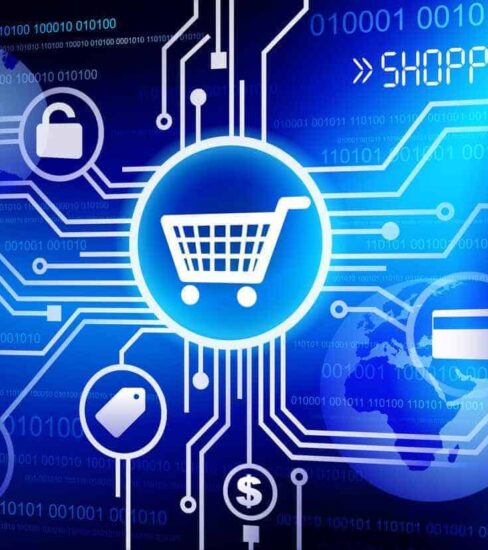The beginning of a new fiscal year is an excellent time to reflect on ways and tools to drive revenue in an industry driven by rapid technological advancements and shifting consumer behaviors. Retail businesses' operational efficiency and revenue generation hinge on leveraging the right technological solutions in this dynamic environment.
Choosing the right Retail Management software is a strategic move that can significantly affect a retailer's ability to improve brand loyalty and maximize revenue, paving the way for future growth and adaptation. The stakes are high, and the need for an RMS with features that help retailers adhere to, foresee, and surpass the unique demands of the modern retail market has never been more pressing.
Before diving head first into a business digitization project, installing more POS terminals, or patching up the existing IT infrastructure, retailers should familiarize themselves with the essential features that help retailers enhance customer experience, ensure business continuity, maintain profitability, and maximize revenue while navigating supply chain disruptions and keeping up with customer demands, requirements, and expectations.
The key features of RMS that are essential for retailers
The Omnichannel Shopping Experience: Bridging the Online-Offline Gap
Omnichannel commerce is not just about being present on multiple platforms; it's about creating a cohesive, integrated shopping experience. It's about understanding that each customer's journey is unique and providing the customer with a personalized experience no matter how or where they choose to shop.
Studies show that customers who use multiple channels to shop with a brand have a 30% higher lifetime value than those who use only one channel, and Retailers with strong omnichannel customer engagement retain an average of 89% of their customers, compared to 33% retention rate for those with weak omnichannel engagement.
This approach is no longer a luxury but a necessity for retailers aiming to thrive in the modern market. Omnichannel commerce blurs the lines between various shopping channels, providing customers with a seamless experience whether they shop online from a mobile device, a computer, or a physical store.
- Consistency Across Platforms: Omnichannel retail ensures that customers receive a consistent experience, whether browsing online or walking into a physical store. This consistency is critical to building trust and loyalty among customers.
- Enhanced Customer Engagement: By integrating various channels, retailers can engage customers more effectively. For example, a customer who abandons a cart online can receive a reminder when they next visit the physical store, or they could get personalized recommendations based on their online browsing history while shopping in-store.
- Increased Sales and Revenue: Retailers that have successfully implemented omnichannel strategies have witnessed a significant boost in sales. Customers appreciate the flexibility and personalized experience, often leading to increased spending.
Offline Access for Business Continuity - Ensuring Uninterrupted Retail Success
According to a Forbes research study, 83% of risk managers have updated their business continuity plans in the past year. The study lists several potential threats to business continuity, ranging from financial crises to disruptions to the connected world.
A business continuity plan is essential to mitigate potential risks, including downtime in sales due to electricity outages or disruption to internet service. Carrying out business as usual during such times is essential to keep sales revenue flowing.
By enabling offline mode in POS, you can ensure that sales are not lost due to connectivity issues.
With offline payment processing, you can still accept payments and process transactions without having to worry about losing out on sales. In addition, disconnected payment processing is a great way to ensure that your business is able to handle any kind of payment, even if your internet connection is down. Once connectivity is restored, the system automatically syncs all pending transactions with their respective online databases.
Moreover, providing offline access strengthens inventory management functionalities by ensuring accurate stock counts regardless of connectivity status.
Employees can manage inventory-related tasks such as receiving new shipments or conducting physical stock checks even during periods of limited internet availability.
Priority's Retail Management Software works flawlessly in both connected and disconnected modes. Once connected to power/internet, all the data is synced to the centralized GUI-driven, cloud-based Head Office management console. The unified database is constantly updated, even during temporary disruptions. As a result, your sales counter or eCommerce checkout page can continuously process payments, leading to enhanced profits.
- Uninterrupted Sales: Sales can continue without hindrance, ensuring no loss of revenue during internet downtime.
- Enhanced Customer Experience: Customers enjoy uninterrupted service, enhancing their overall experience and satisfaction.
- Business Resilience: Retailers can operate confidently, knowing their sales aren't dependent on constant internet connection.
Using point-of-sale (POS) terminals with robust offline functionality is a strategic business decision that holds significant weight for retailers. Its ability to operate under various circumstances is critical for ensuring uninterrupted customer service and revenue flow. By enabling POS terminals with strong offline capabilities, retailers can mitigate the risks associated with connectivity issues and system downtime, which can significantly impact their bottom line. A robust offline function enhances the customer experience and contributes to the overall efficiency and effectiveness of business operations.
Advanced POS Solution for An Integrated Environment
58% of consumers revealed that past customer service influenced their decision to purchase in the future. Delays during checkout, waiting in line, and billing errors contribute to customer dissatisfaction. In other words, ensuring a seamless shopping experience at retail stores is essential.
When retailers expand their business and witness a growth in the number of customers and footfalls, the need for additional POS terminals increases, this is especially true during holiday seasons and festivities, when shoppers often swarm stores, leading to congestion at billing counters. If customers are forced to wait too long, chances are they will abandon the cart and leave before checkout.
This can be a major problem for businesses, as it not only results in lost sales, but also creates a negative customer experience that can lead to decreased customer loyalty. To combat this, businesses should strive to make the checkout process as efficient and painless as possible to improve the overall customer experience.
Another advantage provided by comprehensive point-of-sale features within your RMS lies in streamlining payment processing at checkout while simultaneously enhancing customer service experiences.
For instance, integration with various payment gateways enables acceptance of multiple payment methods, such as cash, credit cards, and contactless payments, along with loyalty programs for seamless transaction handling. Moreover, advanced CRM functionality built into modern POS systems allows for more personalized interactions between staff members and customers based on their shopping history – this ultimately fosters stronger relationships, leading to increased repeat business over time.
Priority Retail's unified commerce solution has a modular structure that helps you add POS terminals at will. There will be no sales downtime, and it enables your staff to attend to a large number of customers simultaneously. In addition to traditional POS solutions, Priority also offers self-service kiosks, thanks to which customers can check out quickly. This eliminates overcrowding, reduces labor costs, and improves your revenue.
- Enhanced Customer Service: POS systems integrated with Customer Relationship Management (CRM) tools allow for personalized customer interactions. Sales staff can access customer histories and preferences, leading to tailored service and a better shopping experience.
- Streamlined Payment Processing: The ability to integrate various payment gateways into the POS system means customers can choose from multiple payment options. This flexibility improves the checkout experience and can speed up transaction times.
- Real-time Data Access: Integration with inventory management systems ensures that sales staff have real-time access to stock levels, aiding in effective customer service and minimizing the risk of stockouts.
- By integrating additional solutions such as CRM and various payment gateways into POS systems, retailers can offer a more efficient, personalized, and satisfactory shopping experience. This approach not only streamlines operations but also plays a significant role in enhancing customer satisfaction and loyalty.
- Seamless self service experience: Efficient customer journey, answering the digital customer expectation across the omnichannel purchasing process.
Sales Forecasting and Analytics
A robust demand planning and inventory forecasting tool is an indispensable feature of advanced Retail management systems. This functionality enables retailers to accurately forecast future customer demand and manage inventory and production accordingly, leading to significant improvements in efficiency and profitability.
According to a report by Aberdeen Group, companies with effective sales forecasting are 10% more likely to increase their revenue year-over-year and 7% more likely to hit quota.
- Analyzing Historical Data: RMS can identify patterns and trends by examining past sales data, allowing retailers to make informed decisions about stock levels and marketing strategies.
- Machine Learning and Predictive Analysis: Advanced RMS uses machine learning algorithms to predict future demand based on a variety of factors, including seasonal trends, market shifts, and consumer behavior changes.
- Risk and Opportunity Consideration: Effective sales forecasting helps retailers prepare for potential risks and capitalize on emerging opportunities, thus maximizing profitability.
By utilizing sales forecasting and analytics, retailers can avoid overstocking, optimize their supply chain processes, and stay on top of inventory management. This proactive approach to inventory control minimizes costs associated with unsold stock and ensures that customer demands are consistently met, leading to improved customer satisfaction and loyalty.
Customer Loyalty Management
An effective Retail management software includes tools to manage customer loyalty programs, offering personalized rewards and experiences based on in-depth customer data.
82% of companies interviewed in a survey said that retaining existing customers is cheaper than finding new ones. In addition, loyal customers are likely to spend ten times more than their first purchase.
Most importantly, reducing your churn rate by even 5% can enhance your profitability by 25 to 125%. These figures prove that retaining high-value customers with loyalty programs that appeal to them is essential. The trick is to find loyalty and reward programs personalized to each customer.
To do this, businesses must thoroughly understand their customer base. This means collecting data on customer preferences, customer behavior, demographics, and buying habits. With this information, businesses can create loyalty programs that offer rewards that are tailored to each customer's
An advanced, modern loyalty management platform helps you personalize loyalty programs, assign points, and seamlessly redeem gift cards, even during your store's most crowded moments. Its sophisticated promotions and gift card management features ensure your customers feel rewarded for continuing to do business with you. The results are reduced churn rate, increased customer spending, and enhanced profitability.
Data-Driven Personalization
• Tailored Rewards: By analyzing customer behavior, demographics, and buying habits, retailers can offer loyalty rewards that resonate with each individual's preferences.
• Enhanced Engagement: Personalized loyalty programs encourage repeat business, as customers feel valued and understood.
• Increased Spending: Statistics show that loyal customers are likely to spend more. For example, a study by Bain & Company indicates that increasing customer retention rates by 5% boosts profits by 25% to 95%.
ERP features
Centralized Management and Efficiency:
Many vendors offer retail management software with bundles of ERP functionality integration. This means the ERP and the RMS are not necessarily "native" to each other. It usually means that some work has been done to ensure compatibility, readability, and data sync. It often offers specialized retail management features with added ERP functionalities, suitable for businesses focusing mainly on retail operations.
While this solution may be sufficient at one point, it will inevitably require additional resources in the future to develop new features and capabilities. This is not to mention the higher costs associated with maintenance and the possibility of data falling between the cracks.
A single Solution with Full ERP Functionality Provides a broader range of business management tools, ideal for retailers requiring extensive enterprise-level capabilities.
For those seeking a comprehensive, all-encompassing management solution, a single solution with full, native ERP functionality is often the more advantageous choice.
Why a Single Solution is Preferable:
- Single source of truth
- Seamless Operations: A unified solution eliminates the need to juggle multiple systems, leading to smoother operations.
- Cost-Effectiveness: Reduces the need for additional software or integration, thus being more cost-effective in the long run.
- Comprehensive Insight: Offers a holistic view of the business, from sales to supply chain management, under a single platform.
Priority's Retail Management solution offers a fully featured 360 retail management environment, encompassing Retail Head Office, ERP , ecommerce and POS capabilities on a unified, cloud based platform. This comprehensive solution eliminates the need for multiple system integrations and boasts true omnichannel capabilities.
Key features include real-time inventory control, sophisticated replenishment automation, and a multi-layered pricing system. Additionally, it supports advanced CRM functions such as a robust customer loyalty management system, segmentation, and engagement features. The solution offers a comprehensive range of promotion types, gift cards, and other sales-boosting modules to further enhance sales. By choosing Priority Software's RMS, retailers can ensure they are prepared to navigate the challenges of the current retail environment while positioning themselves for future success.


